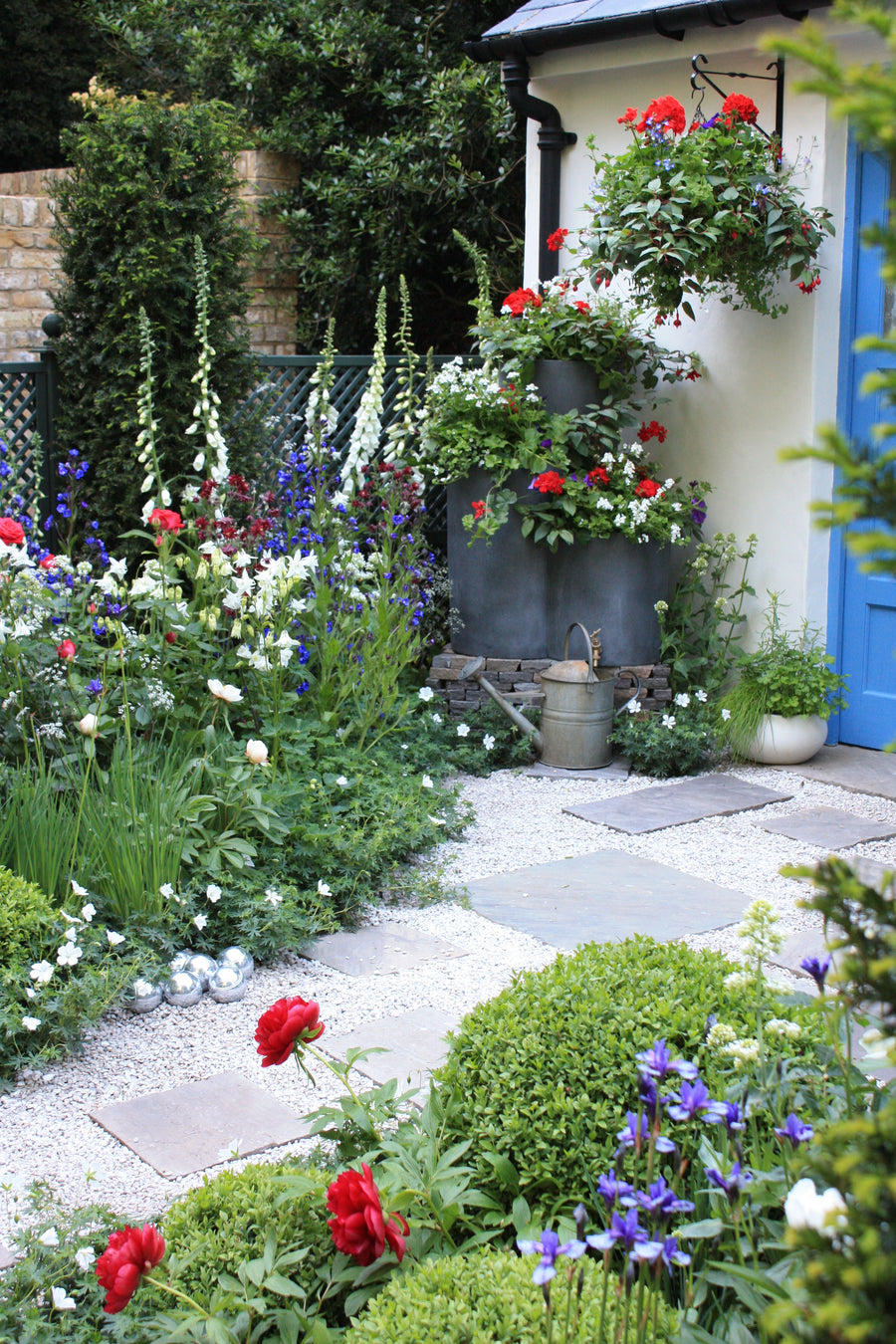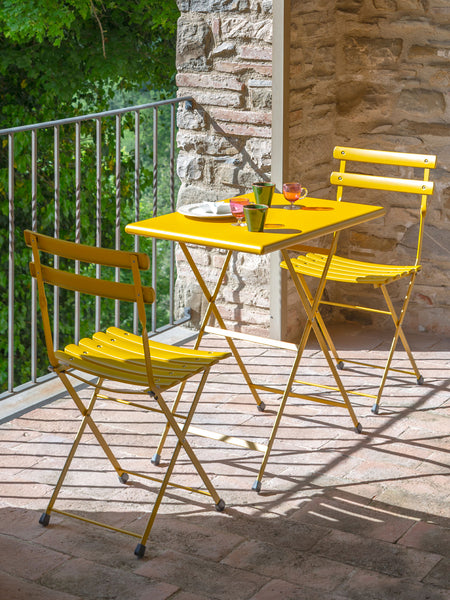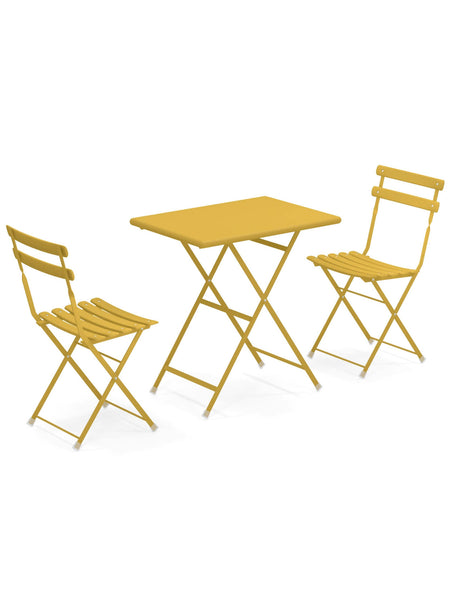If your garden is small, take heart, you are not alone! Whilst the size of an average garden in the UK has decreased over the last half-century, our appetite for outdoor living has grown. A warming climate and our love affair with the barbecue, combined with a lack of space indoors has placed all sorts of new demands on our outside spaces. These days gardens need to function as entertaining areas, workspaces, gyms, meditation rooms, playgrounds and wildlife havens, on top of their traditional roles as places to grow flowers, fruit and vegetables, dry washing or simply sit back and relax. A beautiful garden will enhance the value and desirability of your home and outdoor space is currently top of many homebuyers’ wish lists so it’s worth investing in.
Small gardens, by which I mean those measuring just a few metres in either direction, pose particular design and maintenance challenges, often being shaded, overlooked and lacking good access. The trick, as I have learned from my own tiny, town-centre garden, is to turn every obstacle to your advantage. If a space feels narrow and constrained, there are ways to make it look larger, if there’s no room for a lawn, save yourself a lot of aggravation and use permeable surfaces such as gravel instead.
Small gardens can be easier and less costly to look after whilst offering a comforting sense of enclosure and privacy. Lighting will make a space usable after dark. Designed and planted well, a tiny courtyard or front garden can be as beautiful and versatile as a much larger plot: I’ve seen gardens just two or three metres deep that look as enticing as the biggest landscape park. The trick is never to think small - have big ambitions and wild dreams for your bijou backyard, then find a way to make them fit.
My Top 10 Tips For Designing A Small Garden
- First and foremost, make no apologies for having a tiny garden. Small is beautiful.
- Be clear with yourself and your family about what functions you want your garden to perform and agree on a single priority if you can.
- Lay out your garden with that priority in mind and weave other uses in around it. Activities like drying washing or encouraging wildlife should not require major concessions to your overall plans.
- ‘Borrow’ landscape from neighbouring gardens, parks and countryside. Blur the boundaries between them if you can to cheat the eye.
- Keep things simple. Fewer materials and a limited palette of plants will appear more pleasing and restful.
- Avoid shrinking everything and creating a garden in miniature. Chances are the result will be twee and unsatisfying.
- Select plants that grow more slowly and have a long season of interest. If a shrub flowers for just a couple of weeks and looks miserable for the rest of the year, leave it for those who have space for such indulgences.
- Think about space-saving options such as folding furniture or a storage chest that doubles as seating. Have some extra chairs for when you have visitors.
- Use the vertical plane as well as the horizontal. If you run out of space at ground level, go upwards! There are all sorts of ingenious options you can explore.
- Be prepared for your garden to evolve. It does not have to be everything to everyone at the same time.

Here are some of the questions I’m often asked about making a garden on a small scale:
How can I make my tiny garden feel bigger?
There are lots of cunning ways to make a small garden feel bigger. The easiest is to 'borrow' landscape beyond your boundary to give the illusion that your space extends far beyond: don't box yourself in if there's something attractive in the distance to draw your eye up and out. Distant hills, church spires and trees in neighbouring parks and gardens are classic focal points. Blur your boundaries with shrubs and climbers so the view appears continuous.
Consider how you can lay out your garden to create a sense of mystery. Hide fences with climbers and evergreen plants, and allow paths to meander behind a hedge, panel or trellis to create a sense that something intriguing lies beyond. There’s nothing like a gateway in a wall or fence to make you curious about what’s on the other side.
If you have a particularly narrow plot, laying out paving, beds and lawns on the diagonal can cheat your eye into thinking the garden is wider than it is. Staggering structural planting or ornamental features on either edge of the garden will encourage your gaze to bounce back and forth across the space rather than rush straight to the end. You might also want to think about dividing a long garden into a series of ‘rooms’ that each has a different character and function.
Mirrors are often suggested but they need to be used artfully and purposefully, otherwise, the illusion will be ruined. Consider the impact on wildlife, as birds may be fooled into flying into them.
Whatever you do, don't fall into the trap of scaling everything down to fit. This won't make your garden appear bigger and the result could be fragmented and confusing. Think big and bold, be simple with your planting, dramatic with your colours and the space will expand before your very eyes!
How do I maximise the use of space in a small garden?
Think long and hard about how you want to use your garden before making any changes. If you love to entertain, that may lead to certain choices, if you want to try your hand at growing your own veg, that might lead to others. The chances are you'll want to create a multi-functional space and that requires careful planning. Make sure you understand the fundamentals, such as where the sun falls at different times of day, where the wind blows, places where you are overlooked by neighbours and where you have the best growing conditions - small gardens are often cursed with less than satisfactory soil, or no soil at all.
Consult all the members of your household and draw up a list of priorities. Agree on your number one priority and never waver from it. If your garden isn’t the place you dream of laying in the sun, creating incredible topiary or teaching your children about nature, you will forever be disappointed. You may have to make a few compromises down the line, but outdoor spaces can be surprisingly flexible. Attracting wildlife might simply be a case of choosing the right plants, rather than designing the space differently. Gardens will also evolve as your circumstances and preferences change - they don't have to do everything at once. That rough, daisy-spangled lawn your kids want to play football on can be transformed into a prairie, rose garden or swanky dining space when your circumstances change.
It goes without saying that if you have a front garden, use it. The nation’s front gardens have lost their sense of purpose over the years, often abandoned to car parking, but this is your space to use as you wish. If it’s the only sunny spot and you want to grow vegetables, do it. Perhaps leave the hot tub around the back though.
I learned very quickly to use the vertical plane as well as the horizontal. Go upwards to screen out eyesores but also increase your opportunities for planting. Pergolas, trellises, obelisks, woven willow pyramids, bean teepees, tall pots and hanging baskets are all useful vertical accents for small gardens and in the smallest spaces you can create a green wall using hanging pocket planters.
What are the best trees to grow in small gardens?
The good news is that you have lots of planting options, however unpromising you think your situation is. What you don’t have is the luxury of buying any tree that takes your fancy and hoping you’ll find a way to make it fit somehow. Take your time, make good choices and spend your money wisely.
In my experience there’s really no such thing as a small tree unless you’re talking about bonsai. After 10 years, even a so-called ‘slow-growing’ tree might have reached 4-6m in height and width if allowed to develop naturally. You do have choices though. Narrow, tapering trees are a superb choice for a small garden, particularly if you want to create an avenue, focal point or block an ugly view. I love Liquidambar styraciflua 'Slender Silhouette' and Ginkgo biloba 'Menhir', both of which are straight as a pin and have sensational autumn foliage. Another option is to grow trees that are happy to be pruned. This includes many of the evergreens, fruit trees, limes, beech and hornbeam. The green olive, Phillyrea latifolia is a particular favourite of mine and totally bullet-proof.
For enormous, exotic foliage, try growing the golden Indian bean tree, Catalpa bignonioides 'Aurea' or the foxglove tree, Paulownia tomentosa, and pollarding them annually to 5 or 6ft above ground. Pruned this way, they will never outstay their welcome. Figs (Ficus carica) can take the same treatment but you won’t get to enjoy the fruit. On the subject of fruit, many apples, pears, plums and peaches can be grown against a fence or wall as a fan, espalier or cordon (single stem), producing a decent crop if they’re correctly pruned.
Some trees will grow successfully in pots for a number of years. A container will restrict their roots and therefore their growth. However, they will require significantly more maintenance than if they were growing in the ground. Potted trees need a big container, regular watering, generous feeding and a sheltered spot if you want them to remain happy for a long time. Tall trees in pots are like a ship’s sails; they’ll catch the wind and blow over very easily. Tether them to something stable if you can. Here on the Kent coast we use bungee cords that have a little bit of give in them.
I don’t have a garden, only window boxes. What can I grow in them?
You only have to wander the streets of cities like London, Bath, Harrogate and Edinburgh to understand that windowboxes can be an art form in their own right. The key is to keep the planting simple, ensuring it's weatherproof and drought tolerant.
A single variety of bedding geranium (Pelargonium) can create a startling impression, as so often seen in the Alps, adorning the facade of chocolate-box chalets. Petunias and begonias will create a similar cascade of saturated colour. They’ll flower all summer but need replacing for winter.
A better solution is to form a background planting of one or two evergreens such as ivy, box or euonymus leaving gaps that can be filled with brightly coloured annuals in spring and autumn. This is how many of the grand hotels in London do it, The Ritz included. It keeps up appearances at all times, allowing for seasonal flourishes. Cabbage palms (Cordyline australis) can be used as taller, more dramatic accents. For the ultimate low-maintenance windowbox, hardy succulents can be planted in a gritty compost mix and pretty much left to their own devices. However, they’ll perform much better if watered and fed occasionally.
These are all fairly conventional suggestions and there’s really no need to confine yourself to them. I’ve seen runner beans and tomatoes forming an incredible edible curtain in front of huge sash windows and 2m tall cannas sprouting from the narrowest window ledge. So long as your window box is not going to fall and hurt someone, give your ideas a go.
I have a small garden, but it’s on the roof. What are my options?
Rooftops are often brightly-lit and exposed to the elements with only rainwater available for irrigation. These conditions have much in common with coastal areas and Meditteranean countries.
Roof gardens offer lots of garden-making opportunities, as well as posing a few important restrictions. The greatest limitation is likely to be weight. It's critical that you understand the load-bearing of your roof before you plan anything ambitious. It's not simply a case of working out the dry weight of the materials you're using but how heavy they are when wet. And then there's the weight of plants, furniture and anyone who will be sharing the space with you. If in doubt, enlist the help of a structural engineer or architect.
Once you’re certain of any weight limits, using lightweight materials will extend your options. Your rooftop needs to be sealed so that no water can leak through. Having saturated soil holding water like a sponge on your flat roof is very different to rainwater that quickly drains away.
The depth of soil you can accommodate in raised beds or borders will dictate what you can grow - for example, you'll need at least 60cm to plant a tree. Look to coastal plants from the UK, New Zealand, South Africa and the Mediterranean for inspiration and, of course, many of our favourite herbs and vegetables will thrive on a sunbaked rooftop. Succulents, alpine plants, mosses and some grasses will get by perfectly well with the thinnest layer of soil, grit and gravel. However, be aware of birds that may view your beautiful tapestry of plants as a buffet table …. not so much to eat, but for nesting and rooting around in.
Don't plant anything too tall, especially if you're in a windy spot. Any kind of screening you can provide will help, but make sure it’s permeable. Fixed panels of glass or metal can create wind turbulence as the wind hits them and needs to find somewhere else to go. Finally, if you’ve got furniture, parasols, barbecues or pots, ensure they’re securely weighted down so that there’s no chance they could blow away in a gale.




